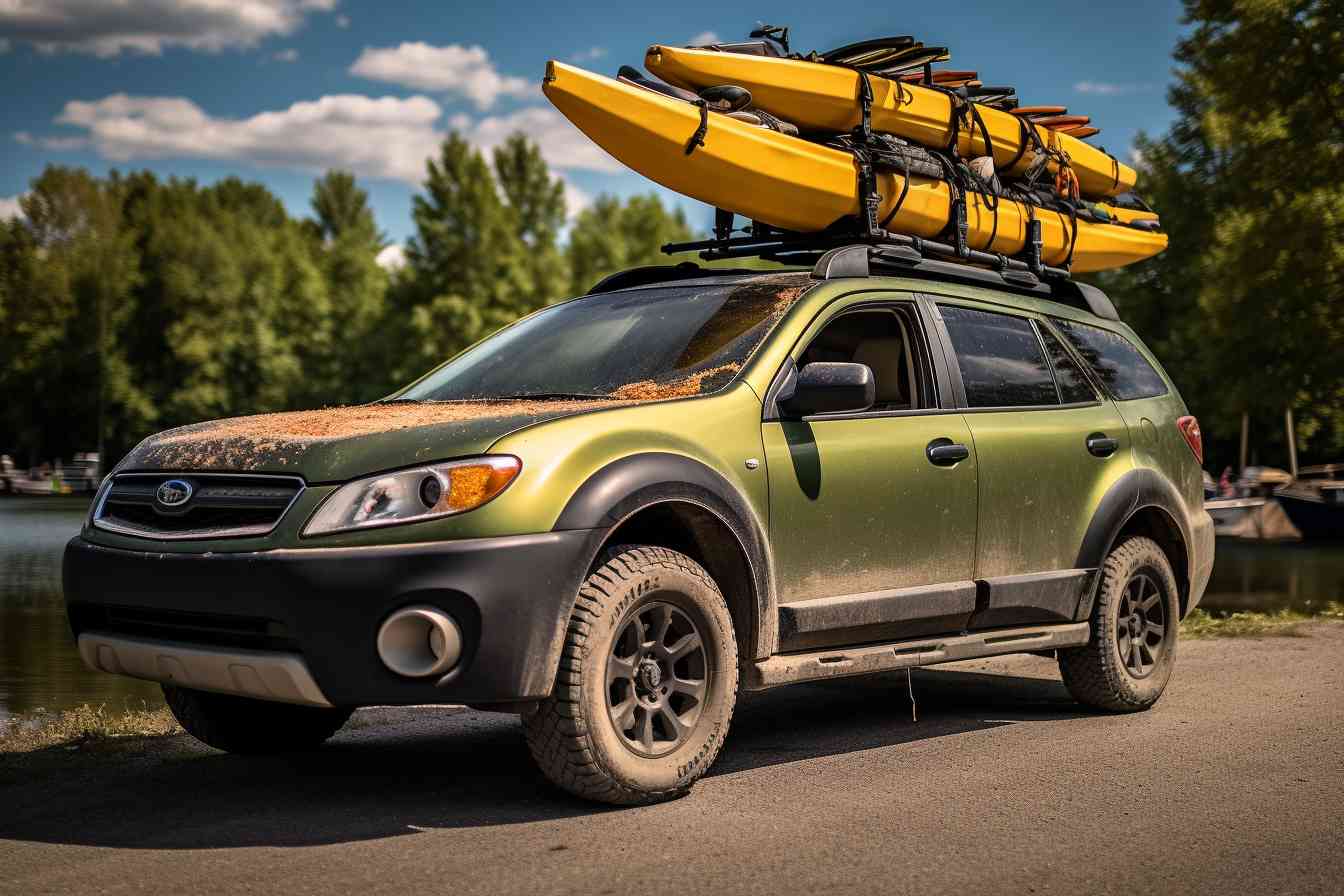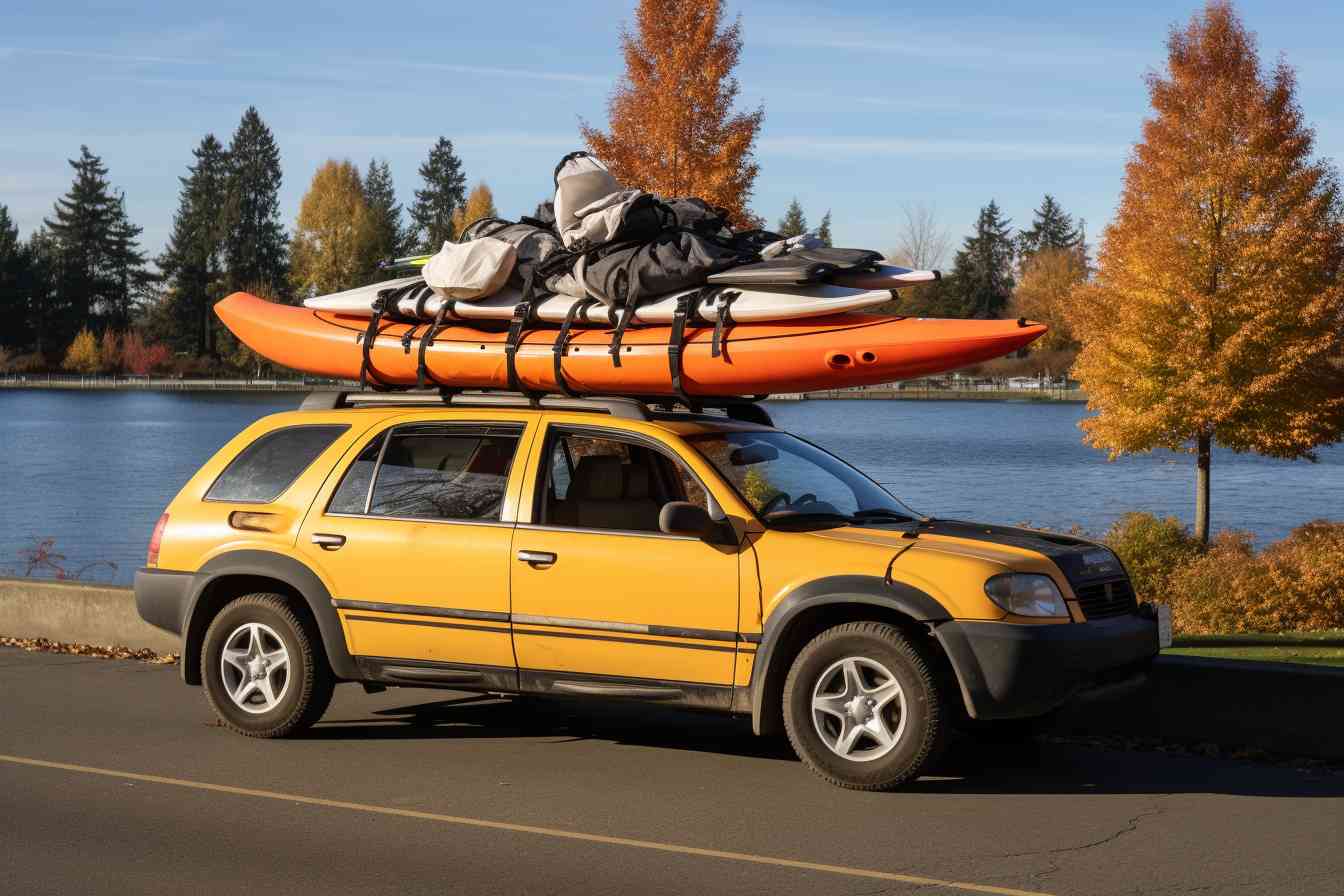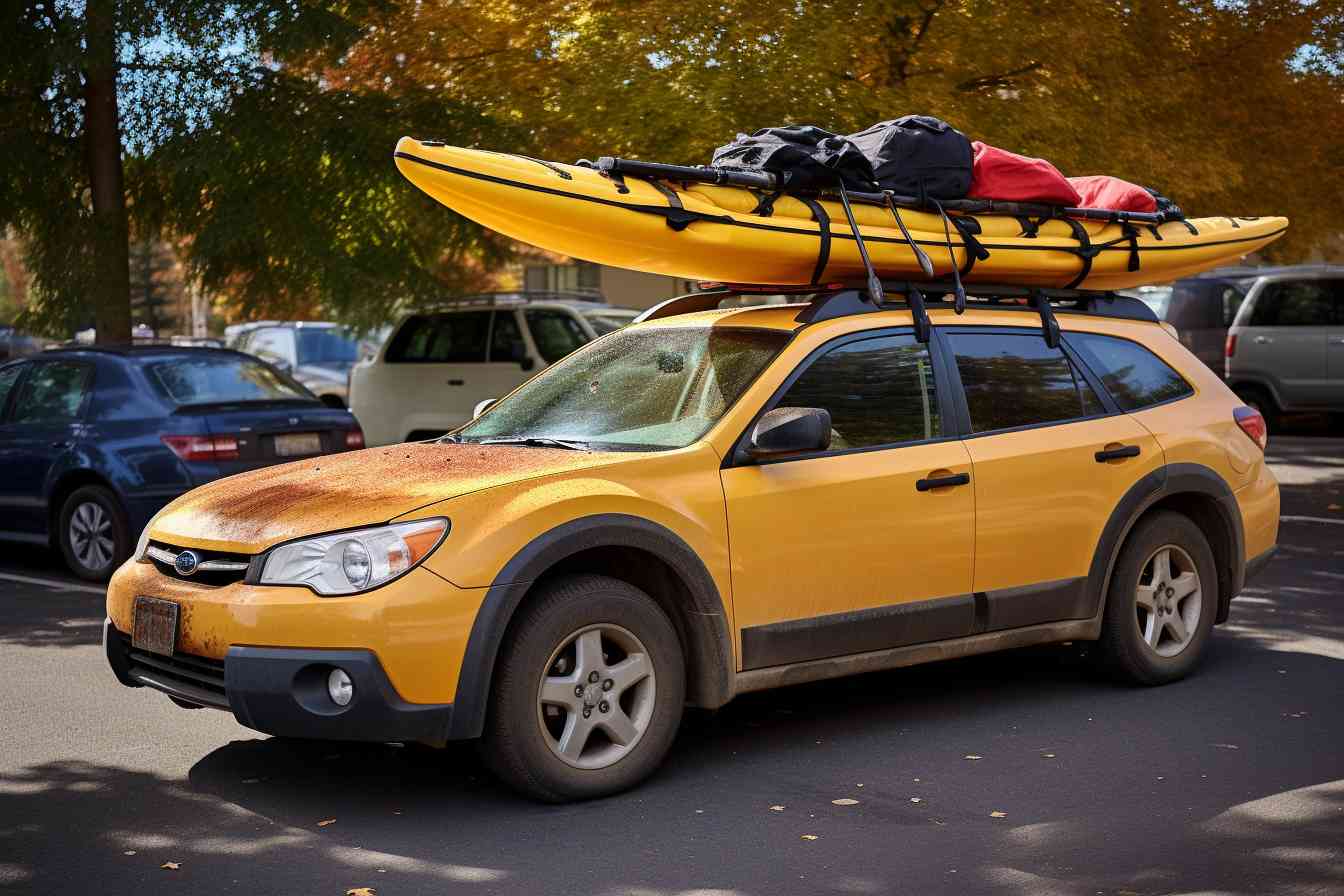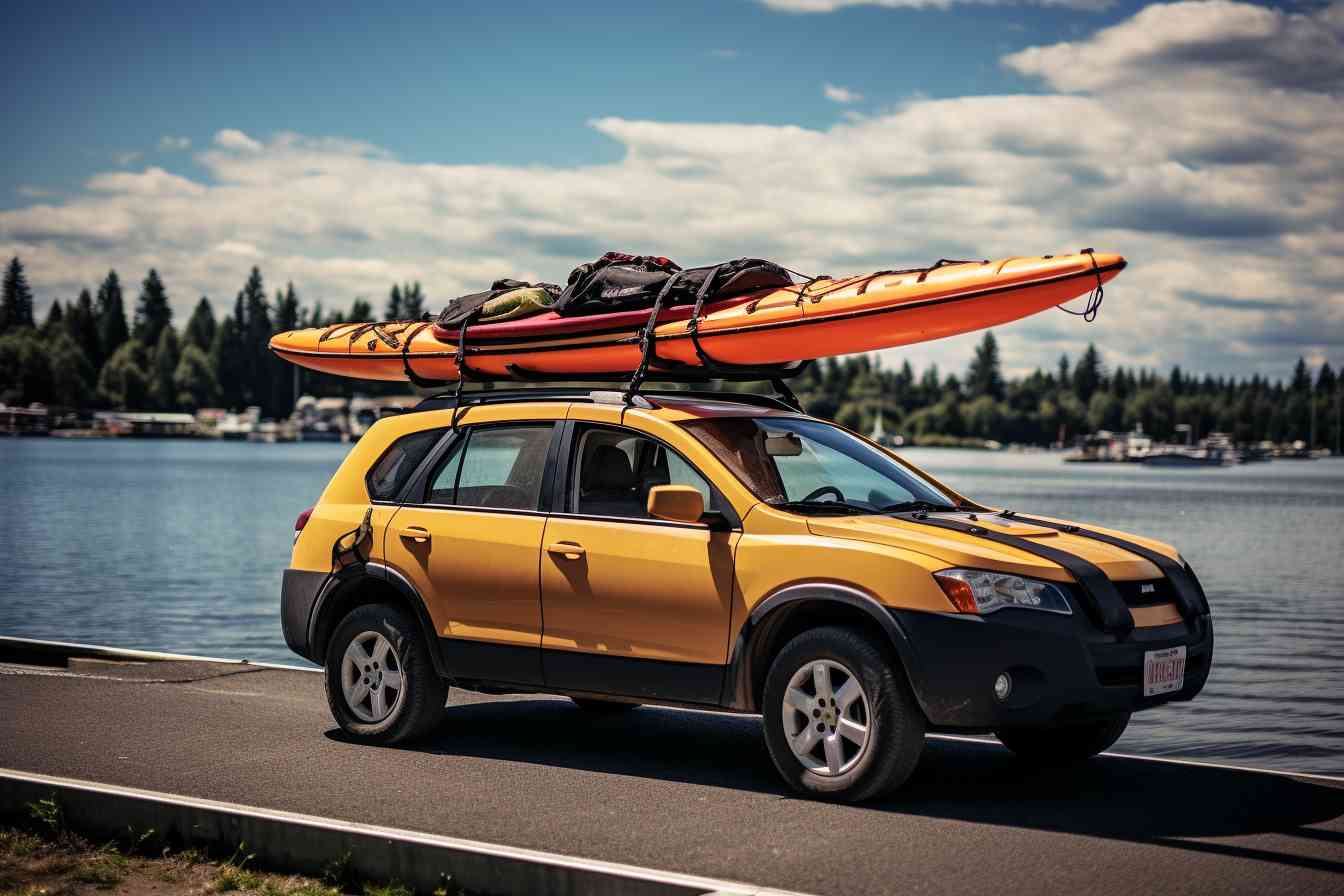Intro: How To Transport A Kayak On A Car

Now, before we dive right in, let’s get a few things straight. We’re going to be talking about something that’s a little tricky… we’re discussing how to transport a kayak on a car. Now, I don’t know about you, but I’ve certainly had my share of challenges with this one. It’s a little daunting when you first get started, isn’t it?
So, first things first, let’s talk about the basics. We’re going to need a couple of essentials – roof racks or foam blocks to secure the kayak, and straps or ropes to hold it in place. You might also need a helper, unless you’re feeling strong… kayaks can be quite the heavy lift!
Okay, the first step is to place the kayak on the roof rack or foam blocks. It’s important that the kayak is placed upside down or on its side, depending on the design of your rack. The curve of the hull should fit snugly against the rack. You don’t want a wobbly kayak while driving, right?
Next, you’ll want to fasten the kayak to the roof rack. Cinch it down – but not too tight. You won’t want to warp or damage the hull. Use sturdy straps or ropes, and make sure they’re wrapped around the kayak and through the car’s roof rack, not through the windows or door frames.
And there you have it! With careful planning and a little elbow grease, you can safely transport your kayak on your car. Just remember to check those straps often during your journey. Safety is paramount, after all!
What Is The Easiest Way To Transport A Kayak On A Car?

Alright, my fellow paddlers, let’s get straight to the point. What’s the easiest way to transport a kayak on a car? Well, I’ll tell ya, from my own experience hauling around my old, hefty kayak, it can sometimes feel like you’re wrestling a plastic whale. But, don’t sweat—I’ve got some tips to spare that will make it a breeze.
The simplest method, and most cost-effective way to transport a kayak, is by using a good ol’ roof rack. They’re pretty much the bread and butter of kayak transportation. Now, if your car already comes with a factory-installed roof rack, that’s terrific! Otherwise, you’ll have to splurge a bit and get one installed. Here’s a little nugget of knowledge—it’s best to invest in a rack that’s specifically designed for kayaks. Trust me on this one, folks.
Once you’ve got the rack installed, put some padding on the crossbars. You don’t want to mar that beautiful kayak of yours. Next, simply hoist your kayak onto the rack, making sure it’s resting on its side, which is the sturdiest part of the kayak.
But, what if you’ve got a small car and a rather big kayak? Well, that may seem a bit tricky. But, don’t fret—you can always snag a hitch-mounted kayak rack or even a trailer.
Remember, the key here is to properly secure your kayak. Straps, ropes, and carabiners are your ultimate best friends in this situation. Ensure that these are tightened, but be careful to not overtighten—your kayak is a fragile beauty after all. Check the kayak periodically during your trip to make sure everything is holding up and the straps haven’t loosened.
The process might seem a bit daunting at first, but with practice, it becomes as easy as paddling downstream. Get out there and glide your kayak onto your car roof—you’ve got some waves to catch!
How To Transport A Kayak Without A Roof Rack
Alright, let’s dive into the topic of transporting a kayak without using a roof rack. This scenario is quite common for kayak enthusiasts who might not have the usual equipment at hand, but still need to move their kayak around. So how do you go about it?
-
Foam blocks can be used: These are strong, dense blocks that elevate and cushion the kayak on your car’s roof. They’re pretty inexpensive to buy and efficient to use. Just ensure you place them far enough apart to evenly distribute the weight of the kayak. You have to keep in mind that while foam blocks make transportation possible, they are not as secure as a roof rack.
-
Using pool noodles is an alternative: Slide a pool noodle under each end of your kayak. The noodles should be wide enough to provide stability. Secure them with bungee cords or ropes by passing through the door of your car or using car windows. Remember, this improvisation won’t be as stable as professional equipment, but it is a viable option for short-distance transportation.
-
Tie-down straps are a must: No matter what solution you choose, tie-down straps are key. They’ll be used to secure the kayak to your car. Ensure you loop the tie-down straps over and around the kayak and through the interior of the car for maximum stability.
-
Use of bow and stern lines: Add these for extra safety. They work by connecting the front and back of the kayak to the front and rear of your vehicle, providing extra stability and reducing the chance of the kayak shifting during transit.
-
Check the state laws: Always ensure to check the rules and regulations in your locality or state related to transporting large items like a kayak on your car. Some places have specific laws related to visibility, overhanging objects, and secured loads.
And there you have it, friends! Remember, this advice is aimed at helping you out in a pinch or for shorter transports. For regular transportation of your kayak, consider investing in a proper roof rack. The safety and peace of mind it offers are really worth it.
How Do You Transport A Kayak Without A Roof Rack?

Alright, let’s get straight into it. If you’re like me, you love hitting the waters on your kayak. But, you’ve likely discovered that the biggest challenge, aside from navigating rapids, is how to transport your kayak. Especially without a roof rack. Don’t worry – I have some tips to share with you!
First off, you’re going to need a few things. Grab yourself some foam blocks, they act as temporary roof bars and protect both your car’s roof and your kayak from scratches. You’ll also need a couple of sturdy tie-down straps. Got them? Great!
So, you’ve got your foam blocks laid out on the roof. Now, it’s time to get your kayak up there. This might require a bit of muscle, but it’s doable. Lift the kayak onto the foam blocks, taking care to position it so it’s balanced and sits comfortably on the blocks. Remember, it’s a kayak, not a seesaw!
Next, throw one of your straps over the kayak and thread it through your car’s open doors. Be sure to buckle it up tight enough so that the kayak doesn’t move, but not so tight you dent your precious vessel. Repeat this step with the other strap at the opposite end of your kayak.
Now comes the most important step. Since you don’t have a roof rack to latch onto, you’ll need to attach bow and stern lines as additional safety measures. Take a long rope and thread it under the front of your kayak and attach to the towing eye located usually under the front of the car. Do the same for the rear. These lines prevent the kayak from shifting forward and backward during transit.
There you have it, you’re ready to hit the road! Just remember to drive carefully. Your precious cargo is up top, after all. Happy kayaking!
How To Transport A Kayak On A Car Without
a rack, Choosing the right equipment, Safety Measures
Getting your kayak from point A to B without a car rack might seem challenging, but following these tips will make the process a breeze:
- Choose your spot: Even without a rack, you’ll need a convenient spot on your vehicle to secure the kayak. Usually, the roof is a good place.
- Use roof pads: They’ll provide a soft surface for the kayak and protect your car’s roof paintwork too.
- Use straps: Long, heavy-duty cam straps are best for this job. Do not use bungee cords as they are not strong enough to secure a kayak safely.
- Position the kayak correctly: Place the kayak upside down, with the hull facing up.
- Secure the kayak: Wrap the straps around the kayak and car, ensuring they are tight but not overly so, to prevent damage.
- Check for movement: Give the kayak a good push to see if it moves. If it does, tighten the straps some more.
Choosing the right equipment for transporting your kayak is equally important. Here are some tips:
- Use bow and stern ropes: While not always necessary, these ropes can add an extra degree of security, especially over long distances or at high speeds.
- Invest in roof pads: If you frequently transport your kayak without a rack, consider investing in a set of roof pads. They offer protection for your car and the kayak.
- Pick the right straps: Secure your kayak with sturdy cam straps. Avoid using bungee cords or ratchet straps, which can damage the kayak.
Safety should always be your top priority when transporting a kayak. Here’s what you need to do:
- Double-check your setup: Before you head out, double-check that everything is secure. A loose strap or improperly fastened kayak can be a hazard.
- Drive carefully: Remember, you’re driving with extra weight on top of your car. This could affect your vehicle’s handling. It’s best you drive at slower speeds and avoid sharp turns.
- Regularly check the kayak: If you’re traveling a long distance, stop occasionally to check that everything is still secure.
- Keep wind effects in mind: High winds can affect your vehicle’s handling when you’ve got a kayak on the roof. So, consider the weather forecast before setting out.
Should Kayaks Be Transported Upside Down Or Right Side Up?

As an experienced kayak handler, I’ve encountered this question a lot: should kayaks be transported upside down or right side up? Well, let me break it down for you. Most experts and I would agree that it’s generally best to transport your kayak upside down. It’s all about reducing air resistance and ensuring the vessel is secure. Plus, the upside-down positioning also better matches the shape of most roof racks, ensuring a snug fit.
Don’t get me wrong—there’s no hard and fast rule that kayaks must always be carried upside down. The right-side-up method can work too, especially if you have a dedicated kayak carrier with padded cradles. But here’s the thing: if you’re traveling at high speeds or over long distances, the wind can get under the kayak and potentially lift it. It’s not what I’d call…an ideal situation.
When you flip your kayak upside down, it’s the deck that gets all the wind pressure. And since the shape of a kayak’s deck naturally diverts wind away, this significantly lowers the risk of your kayak turning into an unintentional parachute. Bonus point: the hull – the part of the kayak that faces up when it’s carried upside down – is generally tougher and more resistant to damage from being strapped down.
Bottom line? Keep it simple, safe, and secure. When in doubt, flip your kayak upside down for transport. If you opt for the right-side-up approach, just make sure you secure your kayak properly and check for any potential airflow issues. Both methods have their place, but I believe upside down gets the upper hand. Safe travels, fellow paddlers!
Do I Need To Tie Down Front Of Kayak?
As a passionate kayaker, I often found myself questioning – do I need to tie down the front of my kayak? Well, the answer is a resounding yes! It’s crucial to tie down the front of your kayak when transporting it on a car. It gives you an additional point of contact with the car, providing extra stability during transit.
Think about it this way- when you’re driving along the highway at high speeds, the wind gusts can play havoc with your kayak. If it’s not properly secured, it might wobble or worse, even slide off the roof rack! This could lead to accidents and, to be honest, that’s the last thing any of us want, isn’t it?
It’s not just about the kayak’s safety, either. Tying down the front of the kayak can also prevent damage to your car’s roof. The last thing we want is a damaged kayak or a dented car roof. So, I’ve always believed in the motto, “Better safe than sorry”.
Here’s how I typically do it. I’d start by placing the kayak on the roof rack, hull side down. Then, I’d use a rope or a ratchet strap, looping it through the kayak’s front handle. The other end of the strap or rope goes through the towing eye at the front of the vehicle. Once it’s snug and secure, it’s all set to go.
Transporting kayaks can be a tricky business, but with the correct technique, it’s a breeze. So, always remember to tie your kayak front down, and don’t forget – the open water is a grand adventure waiting for your arrival. Drive safe, fellow kayakers!
Final Verdict
Well—what a journey it’s been! We’ve paddled through the ins and outs of transporting a kayak, and I hope your mind’s spinning less than a buoy in a storm. Now it’s high time I shared my final thoughts. So, here’s the deal: loading and transporting a kayak on a car isn’t a walk in the park. It requires a good deal of planning and some elbow grease.
The first thing you’ve got to take into account, is the size and weight of your kayak, as well as your vehicle’s carrying capacity. Choose from foam pads, roof racks or J-cradles depending on your car’s set up and your personal comfort and ease. Easy peasy, lemon squeezy. Make sure you’ve got tie-downs, and maybe even a kayak carrier in place if need be.
Always (and I mean always) double-check your straps to ensure your kayak is secure. You wouldn’t want a gust of wind taking you and your precious cargo for a surprise spin down the highway—it’s simply not the kind of water ride we’re aiming for. Remember, safety is key, whether you’re on the water or the open road.
In sum, transporting a kayak is possible for almost any vehicle—you just need the right gear and a bit of patience. Keep your chin up, use a bit of muscle, and you’ll be on the water in no time. Happy paddling, friends!
Frequently Asked Questions
How can I transport a kayak on my car?
You can transport a kayak on your car by using a kayak rack or foam blocks for support. Secure the kayak with straps, making sure it is balanced and not causing any potential damage to your vehicle’s roof.
Do I need any special equipment to transport a kayak?
Yes, you typically need a roof rack or foam blocks to support the kayak and straps to secure it. Some people also use a kayak trailer that attaches to the back of the car.
Can I transport a kayak without a roof rack?
Yes, it’s possible to transport a kayak without a roof rack. You’d use foam blocks or pool noodles for support and secure the kayak with ratchet straps. However, a roof rack is recommended for safety reasons.
How can I secure a kayak to my car?
Ratchet straps or ropes are used to secure a kayak. The kayak should be placed upside down on the rack or foam blocks, and the straps should be looped around the kayak and roof rack or through the car doors if no rack is available.
Is it legal to transport a kayak on a car?
Generally, it is legal to transport a kayak on a car. However, the laws vary based on location, so it’s best to check local regulations.
How can I ensure safety while transporting a kayak?
Ensure that the kayak is securely attached and evenly balanced on your car. Check the straps periodically during your trip to make sure they haven’t loosened. Don’t speed and always follow traffic rules.
What are some tips for transporting a kayak on a long drive?
Ensure the kayak is securely attached, check the straps frequently, and take breaks if necessary. Covering the cockpit with a cockpit cover can help reduce wind resistance and protect the kayak’s interiors.
Can I transport more than one kayak at a time?
Yes, if your car and roof rack can support the weight and size, you can transport more than one kayak. Remember to secure each one individually.
How to unload a kayak from a car?
Start by unfastening the straps, then carefully lift the kayak off the car with the help of a friend if possible. Avoid dragging the kayak as it can cause damage.
What if my car is small, can I still transport a kayak?
Even if your car is small, you can still transport a kayak. You may need to invest in a lighter kayak or a suitable rack. Always ensure the setup is secure and the kayak is not overhanging excessively.

